英语时态ppt课件
合集下载
英语时态8种基本时态讲解.ppt课件

4)动词过去式变化规则。 a)一般情况下的词加-ed. work---worked call----called b)以不发音的字母e结尾的单词直接加-d . live----lived change----changed smoke----smoked die----died graduate----graduated drive----drove
8.过去完成时 表示动作发生在过去某一时间之前已经完成的动作或状态, 强调“过去的过去”, 常与 by the time, by the end of…,before , by 等引导时间的状语连用。
基本结构 主语+ had + 动词过去分词 + 其他成分 When I got to the cinema yesterday the film had begun already. He had learned English before he came here.
现在完成时与一般过去时的区别: 1)现在完成时侧重于对现在的影响;而一般过去时侧重于某一动作发生在过去某个时间或某段时间。即现在完成时侧重于现在的结果,而一般过去时侧重于动作发生的时间。例如:
I have seen the film. 我看过这部电影。(现在我仍记得电影的内容) I saw the film three days ago. 三天前我看了这部电影。(强调是三天前,而不是别的什么时候看的电影)
be going to含有“打算,准备”的意思,而will则没有这个意思, She is going to lend us her book. He will be here in half an hour.
be about to+V.原形(意为马上做某事,在时间上指最近的将来) I am about to leave school. 不能与表示时间的副词连用。 They are about to set out.(√) They are about to set,变y为i加-ed. study----studied carry----carried cry----cried try----tried d)以元音字母+y结尾的单词直接加-ed. play----played stay----stayed
8.过去完成时 表示动作发生在过去某一时间之前已经完成的动作或状态, 强调“过去的过去”, 常与 by the time, by the end of…,before , by 等引导时间的状语连用。
基本结构 主语+ had + 动词过去分词 + 其他成分 When I got to the cinema yesterday the film had begun already. He had learned English before he came here.
现在完成时与一般过去时的区别: 1)现在完成时侧重于对现在的影响;而一般过去时侧重于某一动作发生在过去某个时间或某段时间。即现在完成时侧重于现在的结果,而一般过去时侧重于动作发生的时间。例如:
I have seen the film. 我看过这部电影。(现在我仍记得电影的内容) I saw the film three days ago. 三天前我看了这部电影。(强调是三天前,而不是别的什么时候看的电影)
be going to含有“打算,准备”的意思,而will则没有这个意思, She is going to lend us her book. He will be here in half an hour.
be about to+V.原形(意为马上做某事,在时间上指最近的将来) I am about to leave school. 不能与表示时间的副词连用。 They are about to set out.(√) They are about to set,变y为i加-ed. study----studied carry----carried cry----cried try----tried d)以元音字母+y结尾的单词直接加-ed. play----played stay----stayed
初中英语六种时态复习课件(35张PPT)

②while 引导的从句表示“在……期间”,主从句谓语动词所表示的动 作同时ቤተ መጻሕፍቲ ባይዱ生。这时,主从句都用过去进行时。
e.g.:My father was reading the newspaper while my mother was watching TV.当我的妈妈看电视的时候,我的爸爸正在看报纸。
(2)表示普遍真理或客观事实。 e.g.:The sun rises in the east.太阳从东方升起。 (3)在条件状语从句和时间状语从句中,用一般现在时表示将来。 e.g.:If it doesn't rain tomorrow,we will go for a picnic.如果明天不下 雨,我们将去野餐。 (4)在某些以 here,there 开头的句子中用一般现在时表示正在发生的动作。 e.g.:There goes the bell.铃响了。
(3)现在进行时表示将来 表示位置移动的动词 go,come,leave,fly,start,meet,move 等, 可以用现在进行时表示将要发生的事。 e.g.:We are leaving for London.我们就要动身去伦敦了。
(4)一般现在时表示将来 ①表示按规定或时间表预计要发生的动作。 e.g.:Our plane takes off at 8:10.我们的飞机 8:10 起飞。 ②当主句为一般将来时,或含有情态动词,或是祈使句时,在 if,as soon as,until,when 等引导的状语从句中用一般现在时表示将来。 e.g.:I will give him the book as soon as he comes here.他一来这儿, 我就把这本书给他。
(2)表示当前一段时间内的活动或现阶段正在进行的动作。 e.g.:They are picking apples on a farm all the time.他们一直在农场 摘苹果。 (3)与 always,usually 等词连用,表达说话人强烈的感情,如赞扬、不 满、讨厌等。 e.g.:Mary is always thinking of others instead of herself.玛丽总是为 别人着想,而不为自己着想。
高中英语时态全版.ppt

Tom is seeing his friend off at the airport.
.精品课件.
16
过去进行时 表示过去某一时刻或某一段时间内正在进行 的动作。这一特定的过时间可用时间状语表 示
He was watching TV when I came in.
---What were you doing this time yesterday? ---I was writing a letter.
I will study hard to keep up with my classmates.
He won’t do it.
You shall have the book.
.精品课件.
8
2.be going to + 动词原形:含有打算、计划、 准备将做某事的意思,或表示很有可能要发 生的事。
3.若表示已安排或计划好的将来动作或存 在状态,可用一般现在时代替一般将来 时,其谓语动词常为be, come, go, arrive, leave, start等
Where shall we meet tomorrow?
.精品课件.
7
注:shall和will除了上述表示单纯的将来外, 还有其他用法。在第一人称后,will常表示 “决心”、“意愿”或“打算”,在否定
句中用于所有人称,有“不愿”的意思。 shall用于第二人称时,可表示说明者的将 来意愿或允诺。
the window.)
.精品课件.
4
7. 由here, there开头的句子,动词 用一般现在时表示正在发生的动 作。如:
There goes the bell.
Here comes the teacher.
八大时态讲解(共26张PPT)

He is going to buy her some flowers.
0 一般过去将来时:
He was sixty-eight. In two years he would be seventy.
I knew you would agree.
0 现在英进行语时的: 动词时态(进行) What are you doing?
算;
如:I am going to listen to music. (我打算听音乐) will /shall 表示未事先思考或为计划过的意图
如:It will be Christmas soon .(很快就圣诞节了)
4. 现在进行时态( The Present Continuous Tense )
5、我们离开广州六年了。
We have left Guangzhou for 6 years . ×
We have been away from Guangzhou for 6
years .
3.常见句型
1) 主句(现在完成时)+since 从句(一般过去时).
2) It is +一段时间+ since 从句(一般过去时).
has gone to
He said had seen this morning, …ago, etc
that he _________the film many 如果明天不下雨,我们将去野营。
He has borrowed the pen for three days .
times. 现在进行时态( The Present Continuous Tense )
was /were going to +动词原形
0 一般过去将来时:
He was sixty-eight. In two years he would be seventy.
I knew you would agree.
0 现在英进行语时的: 动词时态(进行) What are you doing?
算;
如:I am going to listen to music. (我打算听音乐) will /shall 表示未事先思考或为计划过的意图
如:It will be Christmas soon .(很快就圣诞节了)
4. 现在进行时态( The Present Continuous Tense )
5、我们离开广州六年了。
We have left Guangzhou for 6 years . ×
We have been away from Guangzhou for 6
years .
3.常见句型
1) 主句(现在完成时)+since 从句(一般过去时).
2) It is +一段时间+ since 从句(一般过去时).
has gone to
He said had seen this morning, …ago, etc
that he _________the film many 如果明天不下雨,我们将去野营。
He has borrowed the pen for three days .
times. 现在进行时态( The Present Continuous Tense )
was /were going to +动词原形
英语八大时态PPT课件(详细版)
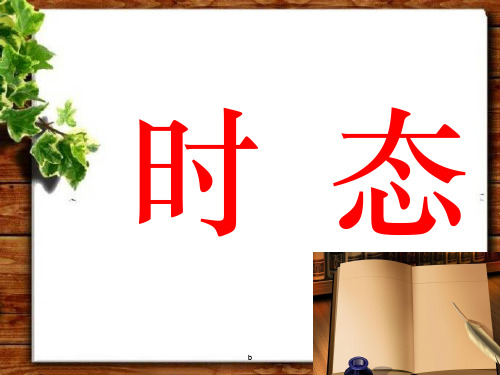
b
15
He is a lazy man . He ____the dirty jeans every day.(2014 )
A. always wears B. always wearing C. always to wear D. is always wearing
You will know the truth after you ___him.(2013) A. see B. will see C. are seeing D.to see
b
16
三、一般过去时
1、构成 一般过去时用动词的过
去式表示。除系动词be的过去式 有人称和数的变化外,其他动词 的过去式无人称和数的变化。
b
17
2、用法
※表示过去已经发生的动作,现在 已经结束,常与相应的过去时间状 语连用。 Tom fell ill last night , and he had to stay at home.
【翻译】
我今年20岁,住在北京。 I am twenty years old this year , and I live in Beijing.
火车将在一个小时后(in an hour)出发(set off)。 The train sets off in an hour.
她每天都走路上学。 She walks to school every day. 或:She goes to school on foot every day.
If it doesn’t rain tomorrow,we’ll
go shopping.
பைடு நூலகம்
b
6
常与一般现在时连用的时间状语有:
often 经常
英语八大时态PPT课件(详细版)
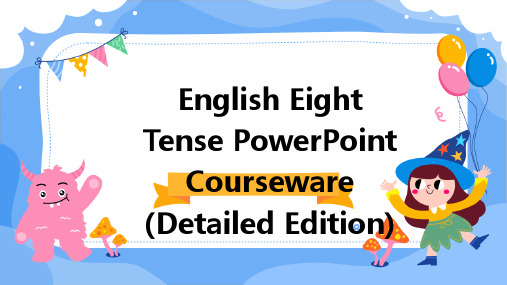
come)
The perfect tense is formed by combining the presentation
particles of the verb with have or has (e.g., he has gone, she has come)
The Composition of the Eight Tenses in English
03
Examples
I have studied, They have played, He has written
Present simple tense
Definition
The present simple tense is used to express an action that is verbal, generic, or not emphasizing time
VS
Tense can be classified into two categories: simple tense and complex tense Simple tense includes present, past, and future tense, while complex tense includes the perfect, the superior, the future perfect, and the conditional perfect tense
Conditional Perfect Tense
It is used to express actions or events that would have been completed in the past if a condition had been met
The perfect tense is formed by combining the presentation
particles of the verb with have or has (e.g., he has gone, she has come)
The Composition of the Eight Tenses in English
03
Examples
I have studied, They have played, He has written
Present simple tense
Definition
The present simple tense is used to express an action that is verbal, generic, or not emphasizing time
VS
Tense can be classified into two categories: simple tense and complex tense Simple tense includes present, past, and future tense, while complex tense includes the perfect, the superior, the future perfect, and the conditional perfect tense
Conditional Perfect Tense
It is used to express actions or events that would have been completed in the past if a condition had been met
英语十六种时态ppt课件

He went swimming yesterday. 昨天他去游泳了。 He was ill yesterday. 他昨天病了。
6
2.一般过去时的肯定、疑问、否定三种形式
肯定式
疑问式
否定式
I worked.
Did I work?
I did not work.
He (She, It)worked. Did he (she, it) work? He (She, It) did not work.
13
范围扩展
1. 用过去进行时表示现在主要是为了使语气委婉、客气。 I was wondering if you can give me a lift. 我不知你能否让我搭一下车。 (一般过去时也有类似用法,但比较而言,用过去进
行时显得更客气,更加不肯定。)
2.动词be的过去进行时也可表示过去一时的表现或暂时的 状态。
现在进行时表示说话时正在进行的动作或表示目前一段时 间内正在进行的活动,与现在进行时连用的时间状语有now, these days等。
—What is your mother doing now? 你的妈妈正在干什么? —She is cooking for us. 她正在为我们做饭。 2.现在进行时的具体用法
10
用法
例句
(1) 说话瞬间正在发生的动作,常见的时间 They are watching TV now.
状语有now,at the moment等。如果句首有 他们现在正在看电视。
警示性动词look,listen等,主句的动词也 Listen! The bird is singing in the tree.
(2) be (am, is, are) going to + 动词原形 2.一般将来时的用法
6
2.一般过去时的肯定、疑问、否定三种形式
肯定式
疑问式
否定式
I worked.
Did I work?
I did not work.
He (She, It)worked. Did he (she, it) work? He (She, It) did not work.
13
范围扩展
1. 用过去进行时表示现在主要是为了使语气委婉、客气。 I was wondering if you can give me a lift. 我不知你能否让我搭一下车。 (一般过去时也有类似用法,但比较而言,用过去进
行时显得更客气,更加不肯定。)
2.动词be的过去进行时也可表示过去一时的表现或暂时的 状态。
现在进行时表示说话时正在进行的动作或表示目前一段时 间内正在进行的活动,与现在进行时连用的时间状语有now, these days等。
—What is your mother doing now? 你的妈妈正在干什么? —She is cooking for us. 她正在为我们做饭。 2.现在进行时的具体用法
10
用法
例句
(1) 说话瞬间正在发生的动作,常见的时间 They are watching TV now.
状语有now,at the moment等。如果句首有 他们现在正在看电视。
警示性动词look,listen等,主句的动词也 Listen! The bird is singing in the tree.
(2) be (am, is, are) going to + 动词原形 2.一般将来时的用法
英语语法16种时态介绍ppt课件
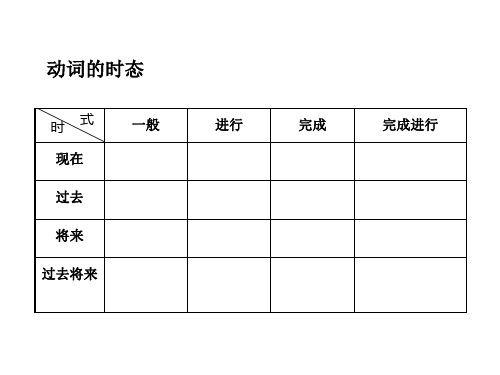
I'll write to you as soon as I arrive there. • 由if 引导的条件状语从句中可以用shall或will表
“意愿”,但不表示时态。
If you will accept my invitation and come to our party, my family will be pleased.如果你愿意接受并 参加我们的舞会,我的家人会非常高兴。
6)祈使句中 ( to give directions or instructions ) Go down the street, and then take the second turning on
the left.
知识扩展:一般现在时表将来
1)下列动词:come, go, arrive, leave, start, begin, return的一般 现在时表将来。这主要用来表示在时间上已确定或安排好的 事情 ( timetabled or fixed events )。 The train leaves at six tomorrow morning. When does the bus start? It starts in ten minutes.
You are always changing your mind. You are always doing well
He’s always asking the same question. 6. 状态动词的进行时后面接形容词brave; careful; stupid; clever; foolish; polite; kind; shy等时,为 主语所表现的非一般惯性特点或故意的行为。
6 )在the more…the more…句型中,从句也要用一 般现在时取代将来时。
“意愿”,但不表示时态。
If you will accept my invitation and come to our party, my family will be pleased.如果你愿意接受并 参加我们的舞会,我的家人会非常高兴。
6)祈使句中 ( to give directions or instructions ) Go down the street, and then take the second turning on
the left.
知识扩展:一般现在时表将来
1)下列动词:come, go, arrive, leave, start, begin, return的一般 现在时表将来。这主要用来表示在时间上已确定或安排好的 事情 ( timetabled or fixed events )。 The train leaves at six tomorrow morning. When does the bus start? It starts in ten minutes.
You are always changing your mind. You are always doing well
He’s always asking the same question. 6. 状态动词的进行时后面接形容词brave; careful; stupid; clever; foolish; polite; kind; shy等时,为 主语所表现的非一般惯性特点或故意的行为。
6 )在the more…the more…句型中,从句也要用一 般现在时取代将来时。
初中英语语法—时态(28张) PPT课件 图文

(4)现在完成时与表示一段时间的for短语、since短语或从句等 时,应注意句中的谓语动词须是延续性的,而不能是非延续性动词,如 come→be here,go→be there,die→be dead,borrow→keep,buy→h ,join→be in,leave→be away,begin to study→study等。
6.过去进行时
(1)概念:表示过去某一时刻或某一时间段内正在进行的动作。 (2)构成形式:was/were+动词的-ing形式 ①表示往返、位移的动词的过去进行时常可用来表示过去将来时
时态 We wanted to tell her that the train was_leaving an hour later.
1.一般现在时
基本用法: (1)表示经常性、习惯性的动作; He always helps others. 他总是帮助别人。
时态 (2)表示现在的情况或状态;
He is a teacher. 他是个老师。 (3)表示客观事实和普遍真理。 The sun rises in the east. 太阳从东边升起。 构成形式:am/is/are或实义动词的原形(主语是第三人称单数时,动 词要用第三人称单数形式)。
时态 (2)构成形式:have/has+动词的过去分词。
(3)与现在完成时连用的时间状语有for a long time,recently,yet, lately,ever,never,already,since,by this time,before,just,in t past/last few years,since+过去的时间点,since+时间段+ago,since +从句(一般过去时)。
表示感觉的动词。如:see,hear等。 表示喜欢或厌恶的动词。如:like,love等。 表示希望的动词。如:want,would like等。
小学英语时态-PPT

一般现在时
(2) 当句子中即没有be动词,也没有情态动词时 ①陈述句:We get up at 7:00 every morning. 疑问句→Do you get up at 7:00 every morning? 否定句→We don’t get up at 7:00 every morning. ②陈述句:She has a little brother. 疑问句→ Does she have a little brother? 否定句→ She doesn’t have a little brother.
现在进行时
1. The boy is playing basketball. 否定句:____________________________ 一般疑问句:_________________________ 肯定回答:__________________________ 否定回答:__________________________
12. We _________ (not watch) TV on Monday.
13. Nick_______ (not go) to the zoo on Sunday.
14. They _________ (like) the World Cup?
按要求完成句子
1.Do you often play football after school? (肯 定回答) 2. I have many books. (改为否定句) 3. Gao Shan’s sister likes playing table tennis (改为否定句) 4. She lives in a small town near New York. (改为一般疑问句) 5. I watch TV every day. (改为一般疑问句) 6. David has got a goal. (改为一般疑问句)
英语四大时态复习课件ppt

• I lost much money last night.( C )
经营者提供商品或者服务有欺诈行为 的,应 当按照 消费者 的要求 增加赔 偿其受 到的损 失,增 加赔偿 的金额 为消费 者购买 商品的 价款或 接受服 务的费 用
改一般疑问句的方法:
①首先看有无be或情态动词,如果有,将be提到 句首并大写,句末打问号.
3对比
时态 现在进行 时
一般现在 时
一般过去 时
一般将来 时
表格对比学习
肯定句
否定句
一般疑问句
be+v-ing 在be 后加上not Be提到句首
(现在分词)
V -原形 V-s/es三单
在实义v.前用助动词 Do,Does 提
don’t ,doesn’t,行 到句首,实
为动词要还原
义动词还原
V-ed
化
Do you usually take the bus to work?
操
I don’t usually take the bus to work. 4.They are having classes.
练
Are they having classes?
They aren’t having classes.
判断时态形式:
A.现在进行时 B.一般现在时 C.一般过去时 D一般将来时
• He always likes playing the piano.( B )
• We are having an English classes now.( A)
• They often go home late.( B ) • Lucy is going to dance tomorrow.( D )
高一英语时态讲解ppt课件.ppt

tomorrow.
(否定句)
Will I/ you/ she/ we/ they watch TV tomorrow?
(一般疑问句)
肯定回答:Yes, I/ you/ she/ we/ they will. 否定回答:No, I/ you/ she/ we/ they will not(won’t).
行 时
肯定:Yes,he/she is. 否定结:构N:o, he/she isn’t.
Sb. +is /are /am + v-ing.(肯定句)
SWb.e+/Tishne’ty//aYroenu’ta/raemwnaottc+hvin-igngT.(V 否no定w句.()肯定句)
IsW/Aer/eT+hSeby./+Yov-uinagr?e(n一’t w般a疑tc问hi句ng)TV now.(否定句) 肯A定re回w答e/t:heYeys/y, osbu. +wisa/tacrhe/inamg .TV now(?一般疑问句)
认识到了贫困户贫困的根本原因,才 能开始 对症下 药,然 后药到 病除。 近年来 国家对 扶贫工 作高度 重视, 已经展 开了“ 精准扶 贫”项 目
一般过去时
I watched TV last night
I watch TV everyday. 一般现在时
I am watching TV now. 现在进行时
一 般
肯定回答: Yes , I/we do. 否定回答:No, I/we don’t现.
He He
/ /
She She
wdoaetcshne’tswTaVtcehveTrVydeavye.r(yd肯ay定. 句()否定句)在时
16种英语时态讲解PPT课件
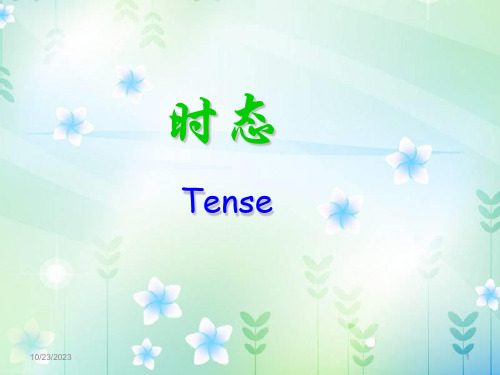
10/23/2023
8
五、现在进行时态
现在进行时的基本用法
形式: am/is/are + doing
用法1: 表示说话此刻动作正在进行.
• He is not available now. he is talking on the phone.
• Please don’t make so much noise. I am studying.
时态
Tense
10/23/2023
1
一、时态概述
16种时态 一般动作
现在 一般现在
过去 一般过去
进行动作 现在进行 过去进行
完成动作 现在完成 过去完成
完成进行动 现在完成
作
进行
过去完成 进行
将来 一般将来 将来进行 将来完成 将来完成
进行
过去将来 一般过去将来 过去将来进行 过去将来完成 过去将来完成
此用法常与一些表示动作频率的时间副词连用(副词放在be动词之 后, 实义动词之前).
1) 表示肯定的频率副词: always, frequently, usually, sometimes, often, occasionally, generally 等.
2) 表示否定的频率副词: never, seldom, rarely 等.
10/23/2023
6
四、一般将来时态
一般将来时的基本用法
形式:
will do 或be going to do
用法1: 表示预测将要发生某事,用will或be going to do.
1) be going to 特别意指根据目前的明显迹象来推断某件事 要发生; will 则只是表名说话人认为或相信某件事要发生
英语八大时态PPT课件(详细版)

时态
A
知识导航
种类
一般现在时 一般过去时 一般将来时 现在进行时 现在完成时 过去进行时 过去完成时 过去将来时
构成
do/does did will/shall+动词原形 am/is/are + doing have/has+过去分词 was/were + doing had+过去分词 would/should+动词原 形
A
4
※表示主语所具有的特征、性格、 能力、状态等
She is a middle school student. She looks a little worried. ※某些以here/there开头的句子 中,用一般现在时表正发生的动 作
Here comes the bus.
A
5
※表示将来发生的、时刻表上不改变的事 The train leaves Hunan at five o’clock. ※特殊情况 在时间状语从句和条件状语从句中,若主 句用一般将来时,则从句用一般现在代替 将来。(主将从现)
A
21
四、一般将来时
1、构成 一般将来时态由
“will/shall+动词原形”构成,me to ask Mary for help.
A
22
2、其他表示
※be going to +动词原形:表示 说话人主观的打算或预测。 I am going to look for a job here. It is going to be a fine day for camping tomorrow.
【小试牛刀】 他们昨天这个时候正在吃晚餐。
They were having dinner this time yesterday.
A
知识导航
种类
一般现在时 一般过去时 一般将来时 现在进行时 现在完成时 过去进行时 过去完成时 过去将来时
构成
do/does did will/shall+动词原形 am/is/are + doing have/has+过去分词 was/were + doing had+过去分词 would/should+动词原 形
A
4
※表示主语所具有的特征、性格、 能力、状态等
She is a middle school student. She looks a little worried. ※某些以here/there开头的句子 中,用一般现在时表正发生的动 作
Here comes the bus.
A
5
※表示将来发生的、时刻表上不改变的事 The train leaves Hunan at five o’clock. ※特殊情况 在时间状语从句和条件状语从句中,若主 句用一般将来时,则从句用一般现在代替 将来。(主将从现)
A
21
四、一般将来时
1、构成 一般将来时态由
“will/shall+动词原形”构成,me to ask Mary for help.
A
22
2、其他表示
※be going to +动词原形:表示 说话人主观的打算或预测。 I am going to look for a job here. It is going to be a fine day for camping tomorrow.
【小试牛刀】 他们昨天这个时候正在吃晚餐。
They were having dinner this time yesterday.
小学英语动词时态ppt课件
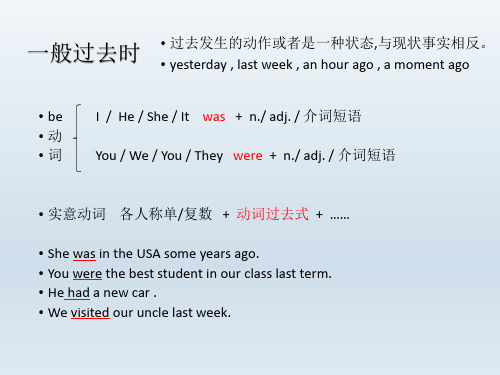
• Mom is sleeping at the moment. • The scientist is doing an experiment this week. • Jack is coming soon. (按计划将要发生的动作) • It is getting dark. (表示事物发生变化的过程)
一般将来时 • 将要发生的动作或事先计划好将要发生的动作。 • next week , tonight , in five minutes
• I / We + shall + 动词原形 + …… • 各人称单/复数 + will + 动词原形 + …… • be going to + 动词原形 + …… • Shall I / We + 动词原形 +…… (征求某人意见时) • 例句:Shall I open the window?
•
I have not finished my homework.
常用助动词:be , do , have , shall(should) , will(would)
• 4. 谓语为“情态动词+实意动词”时:
•
情态动词 + not + 动词原形
• 例句:
•
We can not go swimming this weekend.
三单
does not + 动词原形 He doesn't like ... She doesn't like ... It doesn't like ...
过去时 did not + 动词原形
• 3.谓语为“助动词+实意动词”时:
英语时态讲解课件.ppt
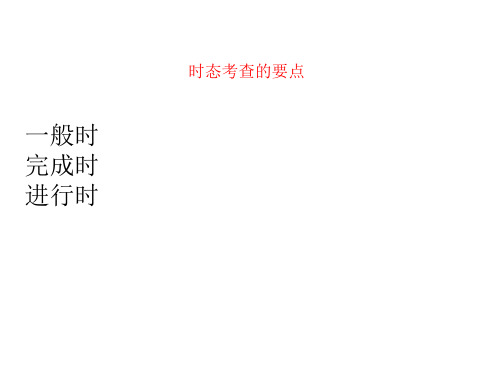
(2)现在完成时表示过去已经开始,持续到现在,也许还会持续下 去的动作或状态。可以和表示从过去某一时刻延续到现在(包括现 在在内)的一段时间的状语连用。 如:for和since,以及 so far, now, today, this week(month, year) 等。
① I haven’t seen her these days. ② She has learnt English for 3 years. ③ They have lived here since 1990. ④ What has happened to the USA in the last 350 years? 注意:表示短暂时间动作的词,如come, go, die, marry, buy等的完 成时不能与for, since等表示一段时间的短语连用。
-ing形式 going, looking
writing, taking
get, sit, put, run, getting, sitting,
begin
running,
beginning
现在完成时
1.现在完成时的构成:助动词have (has) + 动词的过去分词(done)
2.现在完成时的用法: (1)现在完成时表示过去发生或已经完成的某一动作对现在造成 的影响或结果。通常与表示包括现在在内的时间副词just,already, before, yet, never, ever ,up till now 等状语连用。 特别注意的是in the past/last+一段时间。 例如:
A. had met B. have met C. met
D. meet
答案B ;首先本题后句强调对现在的影响,我知道她的模样,你不 用描述。再次,several times告知为反复发生的动作,因此用现在 完成时。
英语时态介绍PPT课件

过去将来时
概念:指将发生的行为或存在状态,以及在过去某一特定时间做某事的意图、 计划或准备。 时 间 状 语 : t h e n e x t d a y ( w e e k , m o n t h , y e a r… ) , s o o n , i n a f e w m i n u t e s 等等。
现在完成时
概念:过去发生或完成的一个动作在现在的效果或结果,或从过去开始并持续 到现在的一个动作或状态。 时 间 状 语 : re c e n t l y , l a t e l y , s i n c e … f o r… , i n t h e p a s t f e w y e a r s 等 等 。
英语时态介绍PPT课件
演讲人
目录
01. 一般现在时 03. 现在进行时 05. 过去完成时 07. 过去将来时
02. 一般过去时 04. 现在完成时 06. 一般将来时
一般现在时
概念:一种频繁、反复出现的动作或行为和当前状态。 时间状语:always,usually,often,sometimes,everyweek等等。
一般过去时
概念:在过去某个时间发生的动作或状态;过去的习惯或惯例的行为、动作。 时间状语:ago,yesterday,thedaybeforeyesterday,lastweek等等。
现在进行时
概念:指在当前阶段或说话时发生的动作和行为。 时间状语:now,atthistime,thesedays等等。 4. 过去进行时 概念:在过去某一特定时间或时刻正在发生或正在发生的行为或动作。 时间状语:atthistimeyesterday,atthattime或以when引导的谓 语动词是一般过去时的时间状语等。
- 1、下载文档前请自行甄别文档内容的完整性,平台不提供额外的编辑、内容补充、找答案等附加服务。
- 2、"仅部分预览"的文档,不可在线预览部分如存在完整性等问题,可反馈申请退款(可完整预览的文档不适用该条件!)。
- 3、如文档侵犯您的权益,请联系客服反馈,我们会尽快为您处理(人工客服工作时间:9:00-18:30)。
注:一般过去时的时间概念是明确的,因为我们关心的是过去 的时间或过去的结果。
-
时间语态
used to…
表示过去经常或反复的动作,也可以用used to 加动词原形或用would 加动词原形。如: When he was a child he would go skating every winter. 在他还是个孩子时,每年冬天都 去滑冰。 My elder brother used to be in the PLA. He is now a police officer. 我哥哥曾经是解 放军,现在是警官。
-
语态分类:
1. 时间语态(时态) 2. 人称语态 3. 被动语态 4. 进行语态 5. 能愿语态(情态) 6. 强调语态 7. 虚拟语态 8. 否定语态 9. 疑问语态 10. 原形语态
-
时间语态
重点申明:
传统语法里,错误地把不属于时间的“进行”当 “时态”—时间语态讲解,造成概念的混乱,使时 态怎么也不能被学会。时态就是动词的时间状态, 凡和时间无关的被动、进行等状态都不应归到时态 中,而应归到另外的语态中。
-
8个时段划分图:
时间语态
-
时间语态
8个时段:
1. 一般现在时段:表示当前时间或一般无明确说明的时间。always ,now, often ,recently, this year, sometimes.
2. 一般过去时段:表示当前时间之前的时间。Yesterday, long time ago, 5 years ago, two days early, in 1949, at the end of last year, when you came, he said
3. 一般完成时段:表示当前时间之前的时间。ever, already, yet, up to now, since, for two years
4. 过去完成时段:表示过去某一说话时间之前的时间,即过去的过去,一般由 上下文暗示出动作发生的时间。
5. 一般将来时段:表示当前时间之后的时间。tomorrow, a while later, in 5 minutes, in the future, at the end of next year
English Grammar (英语语法)
语态部分—时态
-
概念:
语法 : 语言的结构规律。包括词法和句法。词法指词的构成
及变化规律;句法指短语和句子的组织规律。 语态:
动词 特定的 形式或“特殊的”转述意义的方式。用
以表明动作主体和行为之间的关系。(所以,语态是 谓语的不同形式或方式。) 时态(时间语态): 动词的时间状态。(动词特定的形式,用以表达特定 的意思(时间段)。)
一般现在时可以陈述现在时段内发生或存在的事件、动作或情 况,这些说不定会无限期地延续下去。但实际上,我们的意思
是在说“这是现在存在着的状况”。
-
时间语态
一般现在时态--表示将来
这种用法往往用于谈论时间表、节目单或日 程表上所安排好的事项时:
The exhibition opens on January 1st and closes on January 31st. 展览会定于1月1日开幕, 1月31日闭幕。
6. 过去将来时段:表示过去某一说话时间之后的时间,一般由上下文暗示出动 作发生的时间。
7. 一般将来完成时段:表示当前时间到将来某一确定时间之前的时间。by the end of next year, by 2050, before you come next year
8. 过去将来完成时段:表示过去某一说话时间到将来某一确定时间之前的时间, 一般由上下文暗示出动作发生的时间。
He went to town yesterday.
他昨天进城了。﹝昨天,他进城了。﹞(一次动作)
When I was young I took cold baths regularly.
我年青时常洗冷水浴。﹝年轻时,我常冷水浴。﹞(经常性
动作)
I didn’t see him this morning. 我今天上午没有见到他。
在(LONGMAN ENGLISH GRAMMAR)《朗 文英语语法》中,作者Louis Alexander(路易斯• 亚历山大)将时态分为一般(si的汉语翻译版却 重蹈覆辙,同样步入了传统语法的时态误区。
注: «朗文英语语法»是英、美国家的英语语法书。
-
8个时态、时段一览表
时间语态
-
一般现在时态
时间语态
(Present indefinite tense)
基本概念:表示包括“现在”在内的一般现在时段内经常发生 的动作或存在的状态。如:
I get up at 7. 我七点起床。 She visits her parents every day. 她每天都去看望父母。 The earth moves round the sun. 地球围绕着太阳旋转。 Spring follows winter. 冬去春来。 I am a student. 我是一名学生。 My father works in a bank. 我父亲在一家银行工作。
-
时间语态
一般完成时态
基本概念:表示动作发生在过去,但与现在情况有 关系,即用一个发生在过去的动作来说明现在的情 况。动作发生在一般完成时段中。汉语常用 “已”、“已经”、来表示。如:
I have washed my car. 我已洗过我的车了。 I have had my lunch. 我已经吃过午饭了。 We have been here for a long time. 我们已 经在这很长时间了。 注:我们关心是现存的结果,或者过去的事对现在
We leave tomorrow at 11.15 and arrive at 17.50 . 我们明天11时15分动身,17时50分到达。
-
一般过去时
时间语态
(Past Indefinite Tense)
基本概念:表示过去的动作或状态,这种动作或状态可能只限 于一次,也可能是经常性的,但现在已经结束。动作发生在一般 过去时段中。如:
-
时间语态
used to…
表示过去经常或反复的动作,也可以用used to 加动词原形或用would 加动词原形。如: When he was a child he would go skating every winter. 在他还是个孩子时,每年冬天都 去滑冰。 My elder brother used to be in the PLA. He is now a police officer. 我哥哥曾经是解 放军,现在是警官。
-
语态分类:
1. 时间语态(时态) 2. 人称语态 3. 被动语态 4. 进行语态 5. 能愿语态(情态) 6. 强调语态 7. 虚拟语态 8. 否定语态 9. 疑问语态 10. 原形语态
-
时间语态
重点申明:
传统语法里,错误地把不属于时间的“进行”当 “时态”—时间语态讲解,造成概念的混乱,使时 态怎么也不能被学会。时态就是动词的时间状态, 凡和时间无关的被动、进行等状态都不应归到时态 中,而应归到另外的语态中。
-
8个时段划分图:
时间语态
-
时间语态
8个时段:
1. 一般现在时段:表示当前时间或一般无明确说明的时间。always ,now, often ,recently, this year, sometimes.
2. 一般过去时段:表示当前时间之前的时间。Yesterday, long time ago, 5 years ago, two days early, in 1949, at the end of last year, when you came, he said
3. 一般完成时段:表示当前时间之前的时间。ever, already, yet, up to now, since, for two years
4. 过去完成时段:表示过去某一说话时间之前的时间,即过去的过去,一般由 上下文暗示出动作发生的时间。
5. 一般将来时段:表示当前时间之后的时间。tomorrow, a while later, in 5 minutes, in the future, at the end of next year
English Grammar (英语语法)
语态部分—时态
-
概念:
语法 : 语言的结构规律。包括词法和句法。词法指词的构成
及变化规律;句法指短语和句子的组织规律。 语态:
动词 特定的 形式或“特殊的”转述意义的方式。用
以表明动作主体和行为之间的关系。(所以,语态是 谓语的不同形式或方式。) 时态(时间语态): 动词的时间状态。(动词特定的形式,用以表达特定 的意思(时间段)。)
一般现在时可以陈述现在时段内发生或存在的事件、动作或情 况,这些说不定会无限期地延续下去。但实际上,我们的意思
是在说“这是现在存在着的状况”。
-
时间语态
一般现在时态--表示将来
这种用法往往用于谈论时间表、节目单或日 程表上所安排好的事项时:
The exhibition opens on January 1st and closes on January 31st. 展览会定于1月1日开幕, 1月31日闭幕。
6. 过去将来时段:表示过去某一说话时间之后的时间,一般由上下文暗示出动 作发生的时间。
7. 一般将来完成时段:表示当前时间到将来某一确定时间之前的时间。by the end of next year, by 2050, before you come next year
8. 过去将来完成时段:表示过去某一说话时间到将来某一确定时间之前的时间, 一般由上下文暗示出动作发生的时间。
He went to town yesterday.
他昨天进城了。﹝昨天,他进城了。﹞(一次动作)
When I was young I took cold baths regularly.
我年青时常洗冷水浴。﹝年轻时,我常冷水浴。﹞(经常性
动作)
I didn’t see him this morning. 我今天上午没有见到他。
在(LONGMAN ENGLISH GRAMMAR)《朗 文英语语法》中,作者Louis Alexander(路易斯• 亚历山大)将时态分为一般(si的汉语翻译版却 重蹈覆辙,同样步入了传统语法的时态误区。
注: «朗文英语语法»是英、美国家的英语语法书。
-
8个时态、时段一览表
时间语态
-
一般现在时态
时间语态
(Present indefinite tense)
基本概念:表示包括“现在”在内的一般现在时段内经常发生 的动作或存在的状态。如:
I get up at 7. 我七点起床。 She visits her parents every day. 她每天都去看望父母。 The earth moves round the sun. 地球围绕着太阳旋转。 Spring follows winter. 冬去春来。 I am a student. 我是一名学生。 My father works in a bank. 我父亲在一家银行工作。
-
时间语态
一般完成时态
基本概念:表示动作发生在过去,但与现在情况有 关系,即用一个发生在过去的动作来说明现在的情 况。动作发生在一般完成时段中。汉语常用 “已”、“已经”、来表示。如:
I have washed my car. 我已洗过我的车了。 I have had my lunch. 我已经吃过午饭了。 We have been here for a long time. 我们已 经在这很长时间了。 注:我们关心是现存的结果,或者过去的事对现在
We leave tomorrow at 11.15 and arrive at 17.50 . 我们明天11时15分动身,17时50分到达。
-
一般过去时
时间语态
(Past Indefinite Tense)
基本概念:表示过去的动作或状态,这种动作或状态可能只限 于一次,也可能是经常性的,但现在已经结束。动作发生在一般 过去时段中。如:
